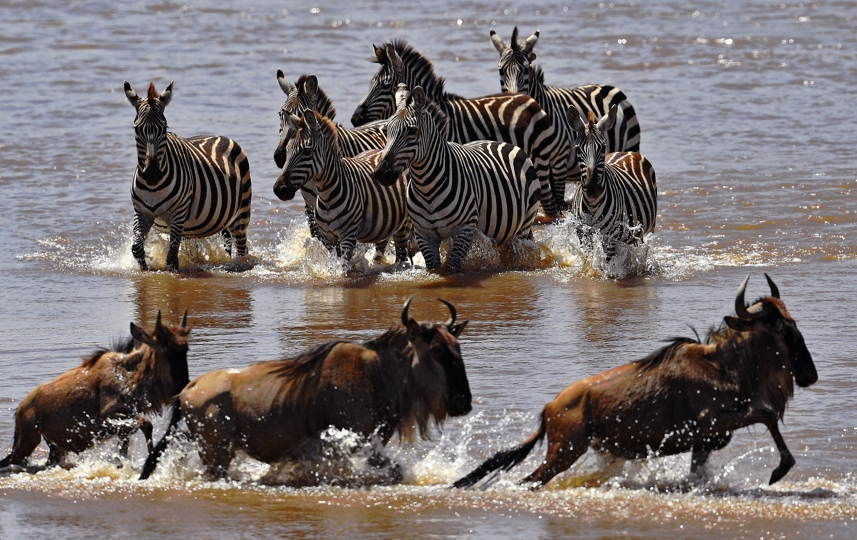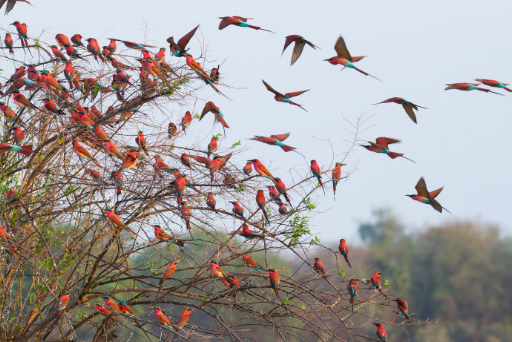Victoria Falls, located on the border between Zambia and Zimbabwe, is one of the most spectacular natural wonders of the world. This UNESCO World Heritage site is famous for its thundering waterfalls, lush rainforests, and diverse wildlife.
However, beyond the falls themselves, the surrounding region is home to a variety of fascinating seasonal wildlife migrations that are less well-known.In this essay, we will explore some of the key seasonal migrations that occur in the Victoria Falls area, including:
- The annual wildebeest and zebra migration in Hwange National Park, Zimbabwe
- The seasonal movements of elephants in Mosi-oa-Tunya National Park, Zambia
- The migration of the carmine bee-eater in Mosi-oa-Tunya National Park
- The seasonal movements of the Nile crocodile in the Zambezi River

We will discuss the timing, routes, and drivers of these migrations, as well as their importance for the local ecosystems and tourism industry. By understanding these seasonal movements, we can better appreciate the complex web of life in the Victoria Falls region and the need to protect these natural wonders for future generations.
The Wildebeest and Zebra Migration in Hwange National Park
Hwange National Park, located just a few hours’ drive from Victoria Falls, is home to one of the most impressive seasonal wildlife migrations in southern Africa – the annual movement of wildebeest and zebra. While not as well-known as the Serengeti migration, the Hwange migration is no less spectacular, with tens of thousands of animals traversing the park in search of grazing and water.

The migration typically begins in November, as the first rains arrive in Hwange. At this time, large herds of wildebeest and zebra begin moving into the park from surrounding areas, drawn by the fresh grass and abundant water sources. Over the following months, the herds continue to grow as more animals join from neighboring countries and private reserves. The peak of the migration occurs between January and March, when the herds are at their largest.
During this time, the animals can be seen grazing in vast numbers across the park’s grasslands and savannas. The herds are constantly on the move, covering large distances each day in search of the best grazing and water. As the dry season approaches in April and May, the herds begin to disperse and move out of the park. Some head north towards the Zambezi River, while others move south towards the Botswana border. By the time the rains return in November, the herds have largely left Hwange, only to return again the following year.

The Hwange migration is not only a spectacular sight for visitors, but also plays a crucial role in the park’s ecosystem. The grazing of the wildebeest and zebra helps to maintain the grasslands and savannas, preventing them from becoming overgrown. The animals also provide food for predators such as lions and hyenas, and their dung helps to fertilize the soil. Unfortunately, the Hwange migration faces a number of threats, including habitat loss, poaching, and competition with livestock.
Conservation efforts are underway to protect the migration routes and ensure that the herds can continue to move freely between Hwange and surrounding areas.
The Elephant Migration in Mosi-oa-Tunya National Park
While not as well-known as the wildebeest and zebra migration in Hwange, the seasonal movements of elephants in Mosi-oa-Tunya National Park are no less fascinating. Located on the Zambian side of Victoria Falls, Mosi-oa-Tunya is home to a small but significant population of elephants that move between the park and surrounding areas in search of food and water.

The elephant migration in Mosi-oa-Tunya is largely driven by the availability of water and forage. During the rainy season, from November to April, the elephants tend to remain within the park, taking advantage of the abundant water sources and lush vegetation. However, as the dry season approaches, the animals begin to move out of the park in search of water and food. One of the most important dry season destinations for the Mosi-oa-Tunya elephants is the Zambezi River, which flows along the park’s northern boundary.
During the dry months, the elephants can be seen making regular trips to the river to drink and bathe. They also forage in the surrounding woodlands and savannas, feeding on leaves, bark, and fruit. As the rains return in November, the elephants begin to move back into Mosi-oa-Tunya, following the same routes they used to leave the park. The migration is a crucial part of the elephants’ survival strategy, allowing them to take advantage of the best available resources throughout the year.
The Mosi-oa-Tunya elephant migration is not only important for the animals themselves, but also for the local ecosystem and tourism industry. The elephants play a key role in shaping the park’s vegetation, helping to maintain the open woodlands and savannas that are home to many other species. They also attract visitors from around the world, who come to see these magnificent animals in their natural habitat.
However, the Mosi-oa-Tunya elephant migration faces a number of threats, including habitat loss, poaching, and conflict with humans. Conservation efforts are underway to protect the migration routes and ensure that the elephants can continue to move freely between the park and surrounding areas.
The Carmine Bee-eater Migration in Mosi-oa-Tunya National Park
Another fascinating seasonal migration that occurs in Mosi-oa-Tunya National Park is that of the carmine bee-eater. These brightly colored birds are a common sight along the Zambezi River during the dry season, but they are actually migratory, spending the rainy season in central Africa before returning to Mosi-oa-Tunya each year. The carmine bee-eater migration typically begins in August, as the birds start to arrive in Mosi-oa-Tunya from their breeding grounds further north.

They are drawn to the park by the abundant supply of insects, particularly bees and wasps, which they feed on. Over the following months, the carmine bee-eaters can be seen in large flocks along the Zambezi River, perching on branches and diving into the water to catch their prey. They also nest in colonies along the riverbanks, digging burrows in the sandy soil to lay their eggs and raise their young.
As the rainy season approaches in November, the carmine bee-eaters begin to leave Mosi-oa-Tunya, heading back to their breeding grounds in central Africa. The migration is a crucial part of the birds’ life cycle, allowing them to take advantage of the best available food resources throughout the year. The carmine bee-eater migration is not only a fascinating natural phenomenon, but also an important part of the Mosi-oa-Tunya ecosystem.

The birds play a key role in controlling insect populations along the Zambezi River, helping to maintain a healthy balance in the local ecosystem. However, the carmine bee-eater migration faces a number of threats, including habitat loss and disturbance from human activities. Conservation efforts are underway to protect the birds’ nesting sites and ensure that they can continue to return to Mosi-oa-Tunya each year.
The Nile Crocodile Migration in the Zambezi River
The final seasonal migration we will explore is that of the Nile crocodile in the Zambezi River. While not as dramatic as the wildebeest and zebra migration in Hwange or the elephant migration in Mosi-oa-Tunya, the crocodile migration is nonetheless an important part of the local ecosystem. The Nile crocodile migration is largely driven by the availability of water and food.

During the rainy season, from November to April, the crocodiles tend to remain in the main channels of the Zambezi River, taking advantage of the abundant water and the presence of fish and other prey. However, as the dry season approaches, the crocodiles begin to move out of the main river channels and into the smaller tributaries and lagoons. One of the most important dry season destinations for the Nile crocodiles is the Mosi-oa-Tunya National Park, where they can be found in large numbers in the park’s lagoons and backwaters.
Here, they are able to take advantage of the abundant food resources and the warm, shallow waters that are ideal for basking and digesting their prey. As the rains return in November, the crocodiles begin to move back into the main channels of the Zambezi River, following the same routes they used to leave the park. The migration is a crucial part of the crocodiles’ survival strategy, allowing them to take advantage of the best available resources throughout the year.

The Nile crocodile migration is not only important for the animals themselves, but also for the local ecosystem and tourism industry. The crocodiles play a key role in shaping the Zambezi River ecosystem, helping to control fish populations and providing food for other predators. They also attract visitors from around the world, who come to see these ancient reptiles in their natural habitat.
However, the Nile crocodile migration faces a number of threats, including habitat loss, poaching, and conflict with humans. Conservation efforts are underway to protect the crocodiles and their migration routes, ensuring that they can continue to thrive in the Zambezi River for generations to come.
Conclusion
The Victoria Falls region is home to a diverse array of seasonal wildlife migrations, from the vast herds of wildebeest and zebra in Hwange National Park to the colorful flocks of carmine bee-eaters along the Zambezi River. These migrations are not only spectacular to witness, but also play a crucial role in the local ecosystems, shaping the landscape and supporting a wide variety of other species.
However, these migrations face a number of threats, including habitat loss, poaching, and conflict with humans. Conservation efforts are underway to protect these natural wonders, but more needs to be done to ensure that they can continue to thrive in the face of growing pressures.
By understanding and appreciating these seasonal migrations, we can gain a deeper appreciation for the complex web of life in the Victoria Falls region. We can also work to protect these natural wonders for future generations, ensuring that they continue to inspire and awe visitors from around the world.
Top Selling Packages
3-Day Victoria Falls Adventure
3-Day Makuni Big 5 Safari Adventure
13 Days Luxury Zimbabwe Safari
10 Days Zambezi and Victoria Falls
9 Days Zimbabwe Victoria Falls Safari
3 Days Victoria Falls Adventure
5 Days Victoria Falls and Hwange
Victoria Falls Honeymoon Itinerary: Romantic Escapes
7-Day Tour: Exploring Victoria Falls
9 Days Victoria Falls and Okavango
6 Days Victoria Falls and Hwange
9 Days Hwange and Victoria Falls
7 Days Victoria Falls, Hwange NP
Packages with Gorilla trekking Experience
9 Days Victoria Falls, Hwange, Matobo
5 Days Victoria Falls and Gorilla
9 Days Luxury Namibia and Gorilla Trekking
12 Days Kruger Reserves and Gorilla
3 Days Uganda Gorilla Trekking
South Africa Packages
12 Days Exclusive Safari and Cape Splendor
10 Days Kruger Private Reserves & Cape Town
12 Days Kruger Reserves and Gorilla Trekking Safari
4 Days Tremisana Lodge Kruger Park Safari
3 Days Kruger and Swaziland Cultural Tour
3 Days Kruger National Park Camping Safari
10 Days Kruger Private Reserves & Cape Town
Namibia Packages
9 Days Luxury Namibia and Gorilla Trekking Safari
6 Days Etosha, Swakopmund & Sossusvlei (Camping)
3 Days Etosha Guided Camping Safari
Zimbabwe Packages
5 Days Victoria Falls and Hwange National Park Safari
4 Day Victoria Falls Fly-in Safari
3 Days Victoria Falls Experience Staying at Phezulu Lodge
3 Days Kariba Sailing Safari (Self-Drive Add-on)
1 Day Victoria Falls, Game Drive with Bush Dinner
9 Days Hwange and Victoria Falls Safari
8 Days Chobe and Victoria Falls Tour
7 Days Victoria Falls, Hwange NP and Matobo NP Experience







Leave a Reply